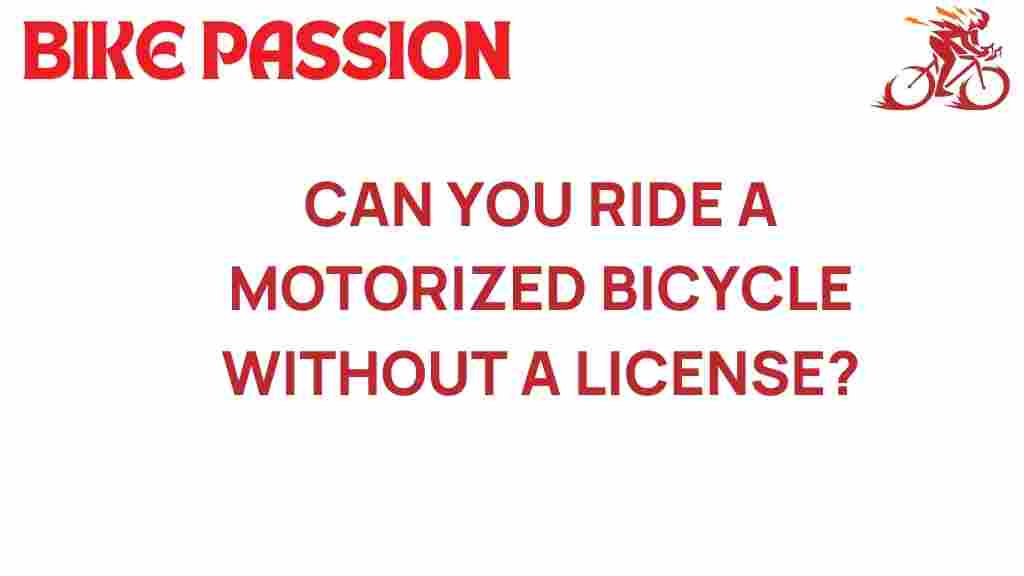The Surprising Truth: Do You Need a License for a Motorized Bicycle?
As the popularity of cycling grows, so does the interest in motorized bicycles. These innovative vehicles combine the convenience of a bike with the power of a motor, making them an appealing choice for many. However, one question often arises: do you need a license for a motorized bicycle? This article will explore the license requirements, cycling laws, and various factors surrounding motorized bicycles, including electric bikes, legal guidelines, and transportation. We will also touch on safety regulations and provide tips for navigating the world of biking with motors.
Understanding Motorized Bicycles
A motorized bicycle, also known as a motorized bike, typically features a bicycle frame combined with a small engine or electric motor. These vehicles can be powered by gasoline or electricity, making them versatile options for commuting or leisurely rides. But before you hop on one, it’s crucial to understand the legal guidelines regarding their use.
The Basics of License Requirements
License requirements for motorized bicycles vary significantly across different regions. In many places, motorized bicycles are classified similarly to traditional bicycles, while in others, they may be considered motor vehicles. Here’s a breakdown of how these classifications work:
- Classification as a Bicycle: In many states, if the motorized bike has a motor with a power output below a certain threshold (often 750 watts or 1 horsepower), it may be classified as a bicycle. In this case, no license or registration is typically required.
- Classification as a Motor Vehicle: If the motor exceeds the power limit or if the bike is designed for speeds greater than a specific limit (often 20 mph), it may be considered a motor vehicle. This classification usually necessitates a driver’s license, registration, and insurance.
Local Laws and Regulations
To determine the specific requirements in your area, it’s essential to consult local laws. Here are some general points to consider:
- State and Local Regulations: Each state has its own cycling laws, and these can vary widely. For example, California has specific laws regarding electric bikes, while New York has different regulations.
- Age Restrictions: Some regions impose age restrictions for operating motorized bicycles. For instance, riders under a certain age may need to wear helmets or obtain a permit.
- Safety Equipment: Many laws require riders to wear helmets and other safety gear to enhance safety while riding motorized bicycles.
To find detailed information about your local laws, consider visiting your state’s transportation website for official guidelines.
Electric Bikes vs. Motorized Bicycles
With the rise of electric bikes, it’s important to distinguish between electric bikes and other types of motorized bicycles. Electric bikes are typically equipped with a battery-powered motor that assists with pedaling, while traditional motorized bicycles may have more powerful engines. It’s crucial to understand how these differences affect license requirements.
- Electric Bikes: Most regions classify electric bikes with a power output of 750 watts or less as bicycles, meaning they do not require a license.
- Motorized Bicycles: If the motor is more powerful or designed for higher speeds, they may fall under motor vehicle regulations.
Step-by-Step Process: How to Determine Your License Requirements
To figure out whether you need a license for your motorized bicycle, follow these steps:
- Identify Your Bicycle Type: Check if your bicycle is considered a motorized bicycle or an electric bike based on its motor specifications.
- Check Local Laws: Visit your local government or transportation website to review the laws about motorized bicycles in your area.
- Consult State Regulations: If your area has specific state laws, ensure you understand those and how they apply to your type of bike.
- Understand Safety Regulations: Identify any safety gear you must wear or equipment you must have.
Troubleshooting Tips for Motorized Bicycle Owners
If you’re facing issues with understanding the license requirements or navigating the laws surrounding your motorized bicycle, here are some troubleshooting tips:
- Contact Local Authorities: If you are uncertain about the regulations, don’t hesitate to reach out to local law enforcement or the traffic department for clarification.
- Join Local Cycling Groups: Many communities have cycling groups that can provide insights into local laws and regulations.
- Review Online Resources: Websites and forums dedicated to cycling can offer valuable information and experiences from other riders.
Safety Regulations for Motorized Bicycle Riders
When riding a motorized bicycle, following safety regulations is crucial for your well-being and that of others. Here are some key safety tips:
- Wear a Helmet: Always wear a helmet that meets safety standards to protect your head in case of an accident.
- Follow Traffic Laws: Adhere to all traffic signals and rules, just like any other vehicle on the road.
- Be Visible: Use lights and reflective gear, especially when riding at night.
- Ride Defensively: Stay alert and be prepared to react to the actions of other road users.
Conclusion
In conclusion, whether you need a license for a motorized bicycle largely depends on the classification of the bicycle, local laws, and safety regulations. Understanding the nuances of cycling laws and license requirements can ensure that you ride legally and safely. Always stay informed about the latest regulations in your area, and prioritize safety while enjoying your ride. For more information on biking laws, you might find this resource helpful.
Embrace the freedom and convenience that motorized bicycles offer, but make sure you’re knowledgeable about the legal guidelines that come with them. Happy riding!
This article is in the category Tech and created by BikePassion Team
